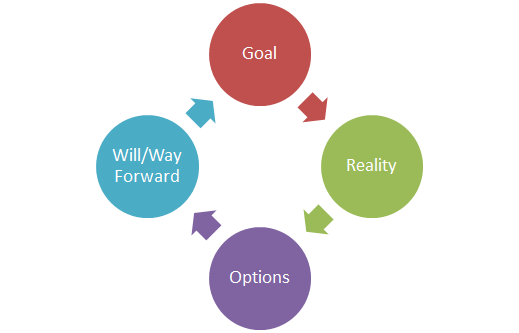As a follow up to “What Makes an Effective Coach,” I will build on the tips presented in the previous blog to create a more consistent coaching style. Initially, I approached coaching relationships with no formal method or technique, other than to be a good listener and ask open-ended questions. Over time, I recognized the need to establish a more structured approach and began utilizing the GROW coaching model (Goal, Reality, Options, Will). It has helped me drive consistency in coaching discussions and enhanced the performance, learning, and development experience of those that I coach.
GROW Model for Coaching
The GROW coaching model, for (G)oals, (R)eality, (O)ptions and (W)ill, was popularized by Myles Downey and serves as standard work in structuring coaching sessions. The following outlines the GROW model as well as an overview of the purpose of each stage:
Goal: To assist the coachee and define outcomes from the coaching session.
Reality: understand what the coachee and team have achieved.
Options: draw out as many possibilities without judgment or evaluation.
Will: assist the coachee and team with selecting the most appropriate next steps. Gain commitment to action.
These stages can be applied for each coaching conversation and can be adjusted depending on the purpose of the coaching discussion (progress review, tollgate review, tool teaching, project startup or closure, etc.).
Questions to Ask Using the GROW Model
To apply this model to your coaching conversations, progress through a series of these questions:
Goal:
- What would you like to achieve in this conversation?
- It sounds like you have two goals. Which one would you like to focus on first?
- What would make the time well spent for you?
- What would be the most helpful thing for you to take away at the end of the conversation?
- If you had a magic wand, where would you like to be at the end of this?
Reality:
- What is happening at the moment?
- How do you feel about this?
- What impact is this having on you? Others?
- What are you doing that is moving you towards your goal?
- What are you doing that is getting in the way of your goal?
- How much control do you have personally over the outcome?
- What resources do you have? What others are needed?

Options:
- What could you do? What ideas do you have?
- Are there alternatives?
- What has worked in the past?
- What steps could you take?
- Who can help you? Where can you go for information?
- What would you do if you had more time/control/money?
- Which options would give the best results?
- What could you do to avoid/reduce risk?
Will/Way Forward:
- What will you do? How and when?
- How committed are you to take that action?
- What will it take for you to commit to that?
- To what extent will this meet the goal you have?
- How will you measure success?
- What is the first step? When will you start?
- What could hinder you from taking this action?
- What will you do to minimize these factors?
- What support do you need? From whom?
These questions are based on the specific needs of each coachee. Select a few questions to begin the discussion.
Coaching Best Practices
In addition to applying the GROW model to coaching engagements, here are three best practices you can adopt to ensure your coaching success:
- Establish a coaching contract—this is an agreement between the coach and coachee on:
- The frequency of coaching sessions (cadence).
- The content of the coaching sessions (tool application, progress review or tollgate review, discuss barriers, change management/soft skills, etc.).
- The involvement of the project team members, Sponsor or Champion, and other stakeholders.
- The accessibility of the coach outside coaching sessions.
- Apply standard practices to coaching sessions:
- Use an agenda to guide each discussion. The coachee should drive the agenda topics.
- Agree on next steps and action items, and the responsible party at the end of each session.
- Utilize a standard mechanism to assess the progress of the coachee.
- Document the discussion and outcomes from coaching sessions. This record and history provide information on coaching discussions, decisions made, and agreed-upon actions.
- Provide the documentation to the coachee after each session.
It has been my experience that people who engage in consistent coaching have higher levels of success executing transformation efforts—the organization sees an increase in operational and financial benefits.
Access our Coaching Template based on the GROW model that can be used to help you have more consistent coaching discussions with those you are coaching. It can also aid in documenting what was discussed and capture agreed-upon next steps.
Want to develop effective coaches in your organization? Our Coaching for Performance workshop and Leader Coaching advisory service package can help. Get a head-start, sign up to receive helpful blogs, tips, and resources from E Squared Solutions.
Contact us to learn more about how we can help you develop more effective coaches.
References:
Coaching for Performance (Sir John Whitmore)
Effective Modern Coaching (Myles Downey)
